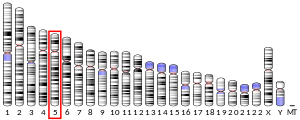MXD3
MAX dimerization protein 3 is a protein that in humans is encoded by the MXD3 gene located on Chromosome 5.[5][6]
MXD3 is a basic helix-loop-helix protein belonging to a subfamily of MAX-interacting proteins. This protein competes with MYC for binding to MAX to form a sequence-specific DNA-binding complex.[6] MXD3 is a transcriptional repressor that is specifically expressed during S phase of the cell cycle.[7] The protein is implicated in both normal neural development and in the development of brain cancer. In medulloblastoma cells, MXD3 binds E-box sequences, leading to increased cell proliferation at moderate MXD3 levels but increased cell death and apoptosis at higher expression levels.[8]
References
- GRCh38: Ensembl release 89: ENSG00000213347 - Ensembl, May 2017
- GRCm38: Ensembl release 89: ENSMUSG00000021485 - Ensembl, May 2017
- "Human PubMed Reference:". National Center for Biotechnology Information, U.S. National Library of Medicine.
- "Mouse PubMed Reference:". National Center for Biotechnology Information, U.S. National Library of Medicine.
- Hurlin PJ, Quéva C, Koskinen PJ, Steingrímsson E, Ayer DE, Copeland NG, Jenkins NA, Eisenman RN (November 1995). "Mad3 and Mad4: novel Max-interacting transcriptional repressors that suppress c-myc dependent transformation and are expressed during neural and epidermal differentiation". EMBO J. 14 (22): 5646–59. doi:10.1002/j.1460-2075.1995.tb00252.x. PMC 394680. PMID 8521822.
- "Entrez Gene: MXD3 MAX dimerization protein 3".
- Fox EJ, Wright SC (February 2003). "The transcriptional repressor gene Mad3 is a novel target for regulation by E2F1". Biochem J. 370 (1): 307–13. doi:10.1042/bj20021583. PMC 1223166. PMID 12444919.
- Barisone GA, Ngo T, Tran M, Cortes D, Shahi MH, Nguyen TV, Perez-Lanza D, Matayasuwan W, Díaz E (July 2012). "Role of MXD3 in proliferation of DAOY human medulloblastoma cells". PLOS ONE. 7 (7): e38508. doi:10.1371/journal.pone.0038508. PMC 3393725. PMID 22808009.
This article is issued from Wikipedia. The text is licensed under Creative Commons - Attribution - Sharealike. Additional terms may apply for the media files.



